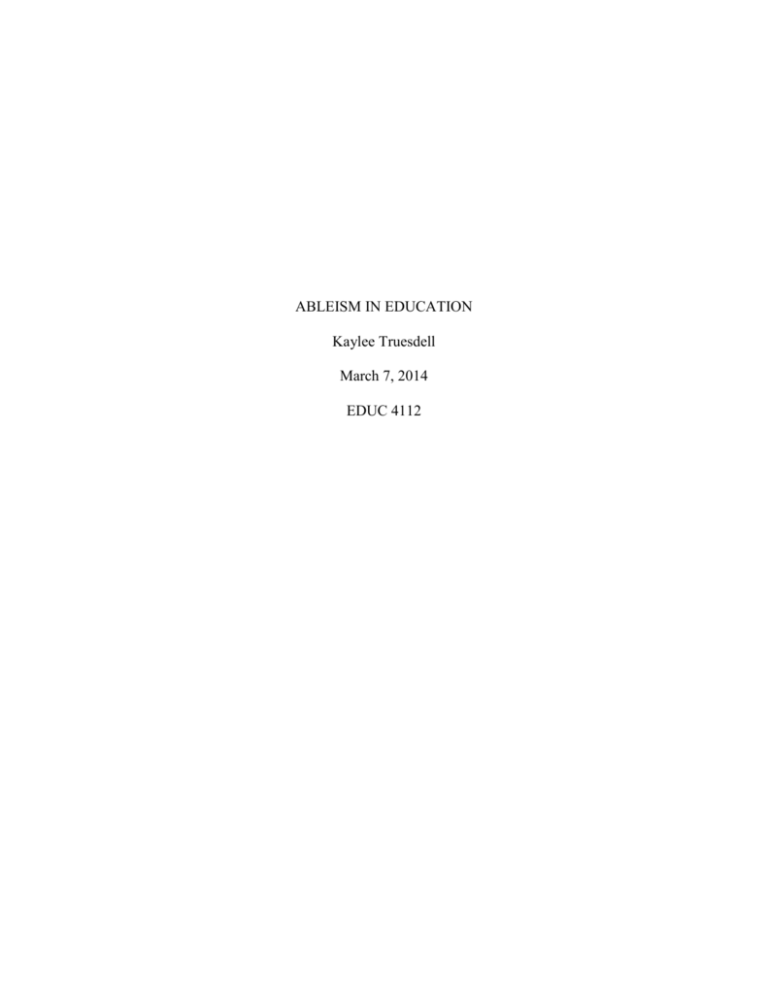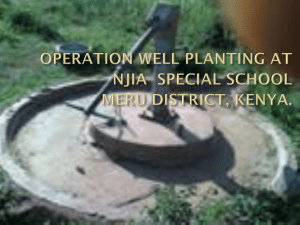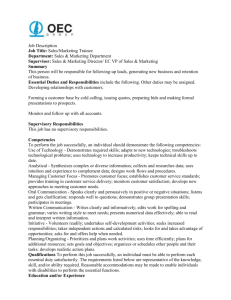File
advertisement

ABLEISM IN EDUCATION Kaylee Truesdell March 7, 2014 EDUC 4112 2 Abstract Ableism, discrimination against people with disabilities, is a common problem in schools today. We are constantly learning new ways to accommodate for students with disabilities, but what if our accommodations cause them to be outcasts? Studies by Thomas Hehir, Brenda Auterman, and Laura O’Laughlin demonstrate that educators and the government may be causing an unintentional segregation in the schools through the Individuals with Disabilities Act, the lack of confidence in individuals with disabilities, and other various issues. In this paper I will research why the government’s laws and the behaviors of the teachers are causing a great divide in schools. I also will find out how this problem can be resolved in schools and why it should be resolved. 3 Table of Contents Introduction……………………………………………………………...... Page 4 Body Paragraph………………………………………………………........ Pages 4- 9 Thomas Hehir……………………………………………………… Pages 4-5 Brenda Auterman………………………………………………….. Page 5 Linda O’Laughlin.…………………………………………………. Page 6 Application and Opinions………………………………………………….. Page 7 Conclusion………………………………………………………………….. Pages 8-9 Bibliography………………………………………………………………... Page 10 4 Ableism is a common problem in schools today that causes disabled students to feel unwelcome in the classroom. Ableism is a view that all people should be “normal” and some people believe that having a disability is a negative thing. People with disabilities are commonly discriminated against and oppressed every day because they are different. Education is also a part of this issue because sometimes students with disabilities are only valued if they “overcome” their problems and are immersed in a normal classroom with normal expectations as if they don’t have a disability. Thomas Hehir believes that you shouldn’t try to cure a disability; rather you should maximize access for students with disabilities by offering support and opportunities so that they are able to participate in the school community. Brenda Auterman believes that even though the country has made great strides with the Rehabilitation Act of 1973 and People with Disabilities Act of 1990, they have also forced segregation and isolation in the schools through those Acts. Laura O’Laughlin also believes that the government has placed a stigma on disabled people. They were trying to make improvements with requiring a least restricted environment, but instead it devalues the students with disabilities in the classroom. Research on the issue of Ableism in the classroom and community Thomas Hehir is a very prominent spokesperson on the subject of ableism. He finds it very important to make sure that the community is aware of the discrimination people with disabilities face and how we can get past ableism in our schools. Hehir believes that the least restrictive environment has made a good impact in the schools because they are able to be included in the classroom (Hehir, 2002, p. 4). They are provided with appropriate accommodations, but they are still placed in the same environment as their peers. He states that 5 this is a good way to bridge the gap and change what is “normal” because the school is not trying to segregate them and “cure” what is “wrong” with them. (Hehir, 2007, p. 9) Another important aspect of ending ableism and integrating disabled students into classrooms according to Hehir is for teachers to have high standards for them. Just like any other student, they will rise to the occasion if someone believes in them and they are intellectually capable to do so. IDEA (Individuals with Disabilities Education Act) requires disabled students to take statewide assessments because they want them to receive the same education as their peers, if they are capable. However, some educators continue to lower the standards for their students because of their disabilities and don’t teach them what they should. In the year 2000, 13,528 disabled students took the Regents English test along with their peers and 9,514 passed (Hehir, 2002, p. 10). Before this, no one believed that they were capable of passing, but that is obviously not true. When given the opportunity, they can rise above the stigma. Hehir says that another sign of ableism is when disabled students are unable to move on to the next grade or graduate without passing a test. Hehir uses the example that it has been decided that reading specifically means reading print or braille. Those who use recorded texts to grasp meaning because they are unable to read are excluded from this definition of reading and therefore do not pass state assessments. They understand how to obtain information from a given text, yet it is believed that they are not on the same level as their peers. Hehir says the job of educators is to push for equality in the school and bring awareness to the problem so it can be resolved (Hehir, 2007, p. 6). Brenda Auterman (2002) believes that, “The crux of any argument against disabled people's attainment of social equality and political equity is the belief that there can be no expectation of success or achievement placed upon a disabled person simply because they are 6 disabled” (Pg 5). Many people in America and across the world believe that only able-bodied people are capable of having great accomplishments. Auterman (2002) states that structural ableism has become a problem because the government has made progressions to build equality for disabled people, but instead they have brought more discrimination on them through these new laws and acts. In the legal sense, the government still has an irrational belief that healthy, able-bodied people should be given more rights and freedom. Disabled people are not synonymous with their disabilities and therefore should not be defined by them. Auterman (2002) believes that disabled people should have high expectations set for them just like everyone else. They are able to be highly capable people, but society rarely gives them an opportunity because they are a “liability”. She believes that the government and American citizens should work together to end the status quo and change their perspective on people with disabilities. O’ Laughlin (2013) argues that the IDEA (Individuals with Disabilities Education Act) has created ableism in the schools because teachers are unable to make accommodations for students in the classroom without singling them out. It creates barriers that are difficult for anyone to break down and actually create the least restrictive environment (LRE). The fact that they are labeled based on their disability instead of as an actual person makes it harder for teachers to move past the diagnosis. All they see is what is written on a piece of paper instead of the actual student and making accommodations becomes more difficult. She says that teachers also need to change their language when discussing students with disabilities and fight to make a change in the legal system (O’Laughlin, 2013, p. 64). Teachers should also be careful when separating students from their peers when the student gets frustrated. It singles them out and brings unwanted attention to them even if the teacher is trying to be 7 helpful. In addition, special education teachers should be mentors for general education teachers and help them understand how to accommodate the student without drawing too much attention. Application and Personal Opinions Hehir’s (2007) view on the least restrictive environment is similar to my own. I believe that it’s a great addition to the IDEA to be able to have students with disabilities integrated into our classrooms. It may make life harder for the teacher, but it should make life easier for the student. They have the opportunity to be with their peers and learn as they learn. They may have special accommodations, but they are still part of the classroom instead of being segregated into a special education class. In classes at Johnson, it has been taught that fair is not necessarily equal. Accommodations have to be made to fit all of our students to make sure they are equipped to succeed. This may mean that a student who has dyslexia will get their test read to them or a student who has behavioral problems is able to go to the back of the room when he/she is getting frustrated. All students have different needs, but in the end it is fair because they are all able to be on the same academic level. O’Laughlin (2013) said that the least restricted environment causes segregation and even though that may be true, it is still in a smaller sense than putting them in special education classes. O’Laughlin (2013) and Auterman (2002) both believe that the government is to blame for why ableism is heavily present in the schools. I agree that the government needs to make improvements to their past decisions involving disabled students to make it easier on them, but I also believe that the government is moving in the right direction. They may not be there yet, but they are making great strides. As Christian teachers I believe it’s important to remember our creator and our purpose on this earth when dealing with disabled students. Romans 3:5 says, “More than that, we rejoice in 8 our sufferings, knowing that suffering produces endurance, and endurance produces character, and character produces hope, and hope does not put us to shame, because God's love has been poured into our hearts through the Holy Spirit who has been given to us” (ESV). All of creation experiences suffering in their lives and those with disabilities are no different. They are still made in God’s image, but the sin of the world got in the way. Our sin caused them to be handicapped because we do not live in the way God intended us to. As Christians, we should be accepting to all people because they have value and they are here for a purpose. We should also be a light to them because they may not have a Christian influence in their life and they deserve to know that God loves them. Leviticus 19:14 says, “You shall not curse the deaf or put a stumbling block before the blind, but you shall fear your God: I am the Lord” (ESV). This verse demonstrates that we should treat those with disabilities with equality. They deserve to be treated as equals because God intended for them to be. Just because some can walk, talk, and communicate perfectly, it doesn’t give them the right to say they are better than someone else. Ableism shouldn’t exist, especially in schools, because schools should provide an equal opportunity education for all people. Conclusions In conclusion, ableism is a serious problem in education today. People with disabilities have been discriminated against enough and it’s time that they are finally treated as equals in society. This should begin in schools where their confidence can grow and they can be free from segregation. Educators should set high goals for all of their students and push them to accomplish them. They should also be careful with their terminology as they discuss disabled students because they need to keep themselves from referring to the disability rather than the 9 actual child. Educators and parents should also be pushing for the government to make a change in their laws for people with disabilities. Awareness needs to be brought to the government because they may not realize that ableism is a big problem in the schools and they may be unsure as to how to fix that problem. Teachers and parents who spend every day with their child would know how they could better accommodate children with disabilities. 10 References Auterman, B. L. (2011). Structural ableism: Disability, institutionalized discrimination, and denied citizenship. (Order No. 1495853, Sarah Lawrence College). ProQuest Dissertations and Theses, , 101. Retrieved from http://search.proquest.com/docview/873567441?accountid=34777. (873567441). Hehir, T. (2007). Confronting ableism . Educational Leadership, 64(5), 9. Retrieved from http://go.galegroup.com/ps/i.do?id=GALE|A160899453&v=2.1&u=tel_a_jbc&it=r& p=GPS&sw=w&asid=3a39e8156c3f156dd4eb3da8785f89be Hehir, T. (2002). Eliminating ableism in education. Harvard Educational Review, 72(1), 1-32. Retrieved from http://search.proquest.com/docview/212279806?accountid=34777 O'Laughlin, L. C. (2013). The least restrictive environment clause of the individuals with disabilities education act and institutional ableism: A critical discourse analysis. (Order No. 3565194, Clemson University). ProQuest Dissertations and These, 163. Retrieved from http://search.proquest.com/docview/1413296531?accountid=34777. (1413296531)








